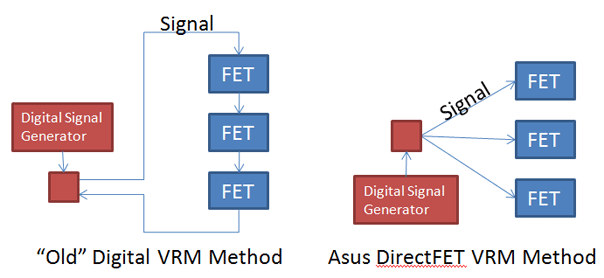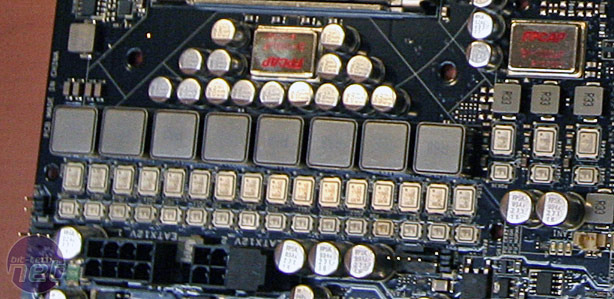
The Immensity's hardcore power hardware... and cost
In times gone by, the advantages of the Voltera "digital" hardware was obvious though - tune the frequency very slightly and the voltage changes were extremely fine - just what the doctor ordered when compared to older motherboards that only let you adjust voltages in 0.25v steps Comparatively, being able to increase ~1/2mV or less was seen as revolutionary. These days we're used to such fine adjustments from even the most basic power hardware, so between this and the fixed cost (the Voltera hardware has to be bought as a set), the system is rarely used.
Asus pointed out that the DirectFET system used on the Immensity is a combination of both the Voltera and more traditional power systems. They use a smaller footprint than normal MOSFETs, but also offer a higher power density and ultra-fine voltage changes thanks to the improved signal generator. The aluminium caps on them give better heat transfer and we were told the large square chokes are no longer iron/ferrite cored - instead they use an unspecified 'metal-alloy'. Asus claims it has tuned the system so each phase to generate "an extra 10 Amps versus the standard design," offering 40 Amp per choke, or 320 Amp in total.
That's actually less than the 480W claimed on some other premium X58 boards, and the mindblowing (yet totally unusable) 1,500W on the Gigabyte X58A-UD9. Neither of which use DirectFETs. EVGA uses the Voltera package on its SR-2 and claims each phase handles 50 Amp - again more than DirectFET.

The DirectFET method accesses all the phases at once in parallel - just like regular MOSFETs. This allows a drop in frequency to only 250Hz vs 800Hz on the all Voltera "digital" design, which means much lower power waste and less heat. Asus claims that if one phase dies, it doesn't break the whole board, although we put this to other industry engineers who state this is false since they are still tied into a common 8-pin 12V input and ground.
Radeon graphics
We asked for clarification whether the inbuilt Radeon GPU was actually a Radeon HD 5450 or HD 5770, to which Asus replied that the board shown at Computex featured a HD 5450, but it wanted a HD 5770 on the Immensity if it was going retail with the design. The HD 5450 just doesn't offer much balance or additional performance to the typical type of card it will be paired with in multi-GPU with Lucid Hydra.We also tried to tally up the board's cost too, although Asus were unspecific and quite unwilling to be tied down to a real price, our estimates with some help on Asus part are as follows:
- Lucid Hydra chip is $20
- Intel X58 at somewhere around $65 (depending on your contract with Intel)
- A mainstream Radeon GPU is anywhere between $25 and $65
- The Lotes LGA1366 socket is $10-15
- MLC Caps each cost over $5, and there are three on this board
- The DirectFETs are "the most expensive solution on the market" - no price attached
- 10 layer (slightly extended) ATX PCB with 2oz copper - no price attached
- Asus' own BIOS flashback hardware costs $10 as well!
Asus seems to be tentative about Lucid's Hydra chip - especially compared to MSI, who incidentally believe that they're better placed to use it, having spent the last year working with Lucid to get the technology working.
Given this, the cost of the board and the general craziness of the design, it's difficult to call the Immensity a serious motherboard - but that doesn't mean we don't enjoy people trying something completely new, which the Immensity does in spades.

MSI MPG Velox 100R Chassis Review
October 14 2021 | 15:04








Want to comment? Please log in.